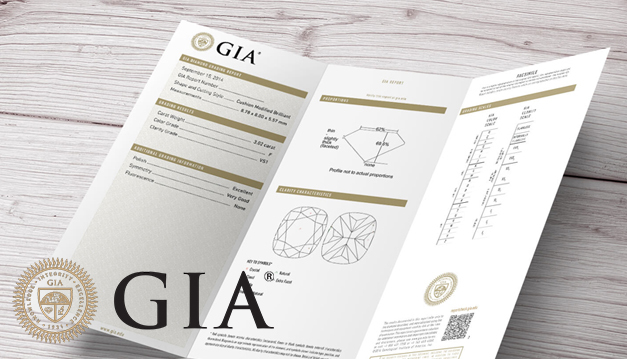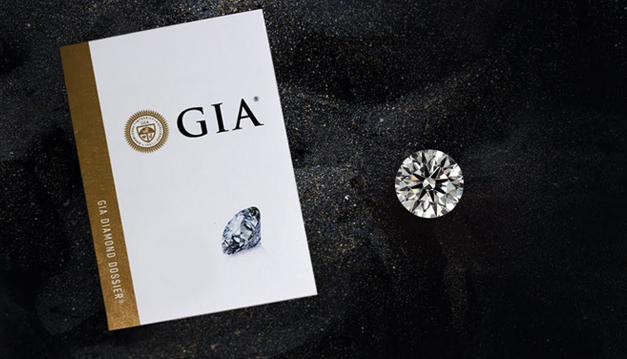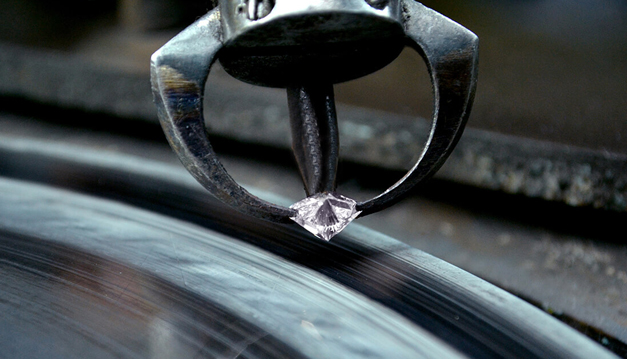GIA diamond grading system serves as the international gem and jewelry industry's benchmark credentials.

The Importance of Diamond Certification
A diamond certificate is also known as a diamond dossier and is a formal document explaining a diamond’s unique characteristics. The Gia diamond grading analysis focuses mainly on diamond cut, carat weight, color and clarity.
The most widely recognized diamond grading laboratory is the GIA (Gemological Institute of America). Trusted worldwide, this grading laboratory is favored among the world’s most famous and reputable jewelers.
Certification by a reputable diamond grading laboratory serves as proof of your diamond’s identity. Diamond grading laboratories are completely unbiased in their grading processes therefore ensuring the GIA certificate information stated is correct and accurate.
A GIA diamond grading process is so important because it proves your diamond’s unique characteristics and identity. The diamond would have to go for independent testing to establish its grading however when purchasing a certified diamond, this step is already completed.
It is important to note that a diamond certificate is not the same as an appraisal or valuation certificate. A diamond certificate gives the characteristics of a diamond but does not place a monetary value on the stone. If you are looking to insure your diamond, you’ll need valuation certificate which is a written estimate of the retail replacement value of the item described.

History of the GIA - Gemological Institute of America
The Gemological Institute of America was founded in 1931. It is the world’s foremost authority on diamond grading. A non-profit organization and upholds the highest standards recognized by the diamond industry. the GIA developed the 4Cs In 1953 and established their diamond and gemstone grading system and today is a worldwide standard. In 1955, they issued their first diamond grading report. Every diamond graded by the GIA is examined by at least four highly qualified, trained and experienced gemmologists. The diamonds are randomly assigned to graders, this allows the process to be completely objective. Every diamond graded by the GIA comes with a GIA Grading Report. This report supplies information on the diamond’s 4Cs (cut, color, clarity and carat weight), as well as notes on the stone’s polish and symmetry and fluorescence. The report normally contains a diagram of the diamond which indicates clarity characteristics, a proportion diagram and GIA grading scales.
The GIA aims to protect both buyers and sellers of diamonds and other gemstones. They do this by setting and maintaining the highest standards that are used to evaluate gemstones. This makes the GIA a trusted source of information for buyers and sellers around the world.
The GIA Diamond Dossier (which is a smaller more compact version of the GIA certificate) includes an assessment of the 4Cs. The Diamond Dossier is only for loose diamonds, D-Z color, weighing 0.15 to 1.99 carats.
Though a GIA certificate contains a lot of information, it is presented in an uncomplicated fashion, and is easy to interpret.
A GIA Diamond Certificate will contain the following information:
| Information | Example |
|---|---|
| A unique certificate number | 1105994015 |
| A description of the shape of the diamond | Round Brilliant Cut |
| The clarity of the diamond | VS2 |
| The color of the diamond | E |
| The carat weight of the diamond | 0.50ct |
| The length, width and depth of the diamond in millimeters | 5.10 - 5.11 x 3.16 mm |
| A description of the cut grade | Very Good |
| The quality of the diamond's polish | Very Good |
| The quality of the diamond’s symmetry | Excellent |
| The presence or absence of fluorescence in the diamond | None |
| The total depth percentage and table percentage of the diamond | 61.9% and 57% respectively |
| A description of the girdle's appearance | Thin to Medium |
| A description of the culet | None |

Some GIA certificates contain additional information such as:
This is in cases where the diamond has inclusions:
Like many official documents, every GIA report has a security feature to prove the authenticity. These include a hologram, security screen and micro-print lines. This prevents reports from being forged or duplicated.

The GIA set the ultimate standard for diamond grading and diamond certification. Today almost all diamonds are graded using their methods and follow their certification processes.
Diamonds are not certified, no lab would say that they are "certifying" diamonds. Legally speaking, it can put them in trouble. All they say is that they grade diamonds based on their best judgement.
A laboratory certification is not an appraisal. An appraisal seeks to establish the value of an item, mainly for insurance purposes. A diamond certificate does not evaluate a diamond's market value, only its characteristics and quality. That said, diamond certification from a reputable laboratory is invaluable in generating an accurate appraisal.
The six main labratories that exist are GIA, AGS/AGSL, HRD, IGI, GSI, and EGL.

A note of caution:
All Labs are not created equal, and their judgments are not held to any objective standard. Unfortunately, some labs have succumbed to pressure from retailers to lower their standards, thereby allowing lower quality diamonds to be certified with higher ratings, increasing their value in the marketplace. Before relying on any diamond certificate, make sure you are comfortable with the reputation and expertise of its author.
Jewel Bear chooses to offer GIA certified diamonds, other labs which have a strong reputation in the marketplace include AGS (American Gem Society) and HRD (more common in Europe than the U.S). Diamonds with certification from labs such as IGI and EGL tend to sell at a small discount, since these labs are known for relaxed diamond grading standards(for example, a diamond graded G in color by EGL may only be graded H by GIA).
Use caution when comparing the price of diamonds graded by two different labs; what at first seems like a bargain may only be the result of more relaxed diamond grading.